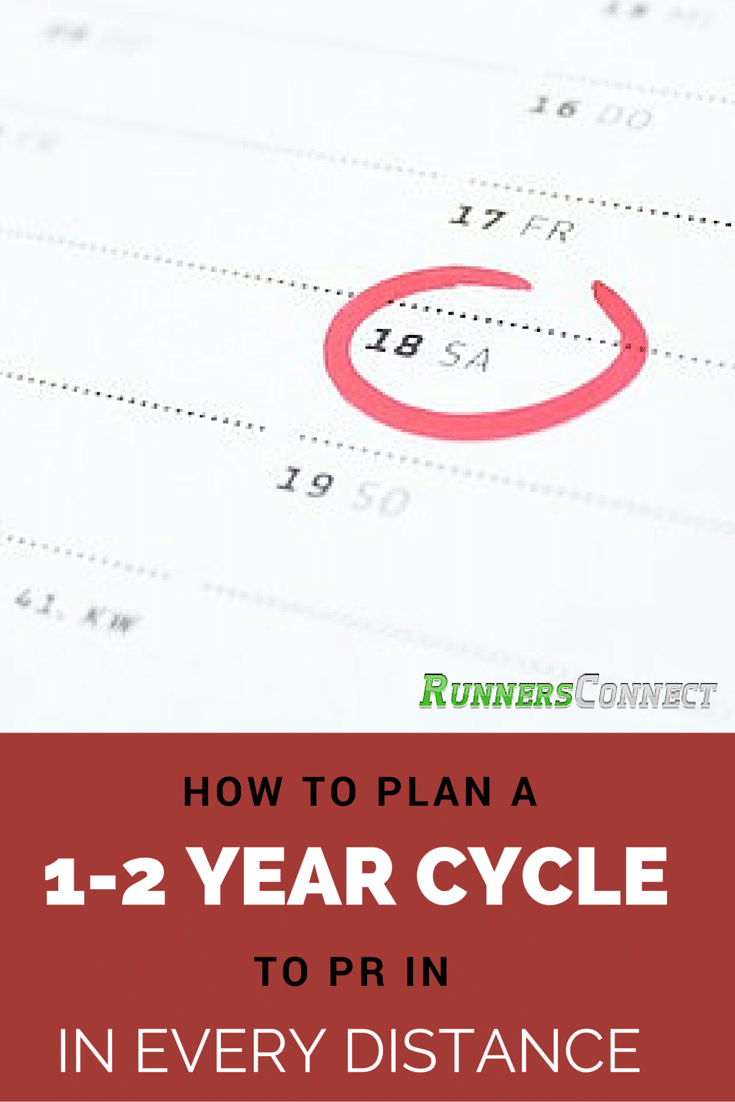 Runners tend to think of training in isolated blocks: 16 weeks of training for this marathon, 12 weeks of training for the upcoming 5k.
Runners tend to think of training in isolated blocks: 16 weeks of training for this marathon, 12 weeks of training for the upcoming 5k.
However, training doesn’t occur in neat little segments like we have a habit of thinking. Each training cycle builds upon the last to improve some aspect of your fitness and to make you a better runner overall.
Therefore, rather than looking at training in independent 12 or 16 week segments, runners should take a holistic and long-term approach to their training and plan their racing and training schedules in one or two year blocks.
This approach sounds fine and dandy if you’ve been running for a long time or if you’re well-versed in training theory.
However, if you’re a new runner or don’t have a strong grasp on exercise physiology, this can be a difficult and confusing task.
It’s no wonder one of the most frequent questions I get from athletes is, “how do I structure my training for a one or two year cycle?”
While each runner is unique, in this article we’re going to explain why you need to vary your training for different race distances over the span of one or two years and then outline a few long-term approaches you can take to train optimally year-round for your favorite distance.
Why do I Need to Vary Distances I Race?
Too often, runners find one race distance they like and continue to train for that one distance repeatedly.
This is especially true for marathon runners, who will often race three marathons a year, in consecutive years, without taking time to work on other aspects of their running fitness.
Not only does continually training for the same goal race distance lead to burnout, but is also one of the main reasons many runners fail to consistently improve year after year.
Here’s why:
All energy systems need to be trained
Each race distance requires that you shift your training focus to a specific set of physiological demands. Certainly, there is overlap between distances, especially the closer they are in length, but the exact demands are still different.
For example, in the marathon, when you are following a marathon training schedule, the primary focus of training is developing your aerobic threshold (the fastest pace you can run while staying aerobic), increasing muscular endurance (how long you can run without your legs falling apart), and fuel efficiency (how efficient you can be at burning fat instead of carbohydrates while running at goal marathon pace).
Conversely, in the 5k, your primary training focus should be increasing your VO2max, improving your speed endurance (your ability to maintain a fast 5k pace for the entire race), and running efficiency (the ability to recruit maximum muscle fibers with each stride without increasing effort).
This means if you’re a marathoner and you neglect training for shorter distances like the 5k for a year or two at a time, you may never get the chance to improve you VO2max and running efficiency.
In the long-term, this will limit your ability to improve at the marathon distance.
A good way to visualize this concept is to think of a how window blinds work.
To raise a blind, you usually have two strings you need to pull. Each string controls one side of the blind. If we imagine the blinds themselves to be your race performance and the strings to represent separate energy systems, you’ll find that you can only raise one side (pull one string) so far before you need to also begin raising the other string.
Your body works in much the same way.
[bctt tweet=”Training for running is like raising blinds? Strange, but makes total sense!”]
No change in stimulus
Along the same line, if you neglect certain energy systems or physiological elements for a long period of time, you start to lose overall fitness.
To continually improve, the body needs a change of stimulus – a new type of demand for the muscles and body.
Repeatedly training for the same race distance, especially if you rehash the same schedule (and do not follow our free marathon training schedule and guide!).
If you simply change the paces, trains your muscles and metabolic systems in the same exact way, it doesn’t ignite growth and development.
What Does an Ideal One Year Cycle Look Like?
Again, each individual runner has their own strengths and weaknesses.
Some runners are more naturally suited for the shorter distances while others can seemingly run forever, but struggle to run anything faster than half marathon pace. However, you can use this general approach and guideline to tailor a yearly schedule that fits your unique running qualities.
Marathon focus
Optimally, you should be running one or two marathons a year so can properly recover and also focus on improving your other energy systems during at least one training segment a year. Here is what racing a Fall and Spring marathon might look like:
- August through October/November – Marathon training (mileage, aerobic development and marathon specific workouts).
- November/December – Recovery and build back into a good, general level of fitness. Include strength work, strides and hill sprints to stay healthy and to touch on speed.
- January/February – Short 4-5 week speed phase. Race a few 5ks and do shorter, speed-oriented workouts while slowly building your mileage.
- February through April/May – Marathon training
- May/June – Recovery and build back into a good, general level of fitness. Include strength work, strides and hill sprints to stay healthy and to touch on speed.
- July through September – Speed development or 5k/10k training. This will help you work on your speed and VO2max.
- September through December – Half Marathon training. Another good change in stimulus and helps improve your top-end anaerobic threshold
From here, you can run another Winter or Spring marathon and repeat the cycle.
This one year cycle provides you one shorter and one longer opportunity to work on energy systems and training outside your goal event and will leave you primed for your best marathon results during your next training segment.
Make sure you check out our article comparing the best marathon training programs.
[bctt tweet=”Is your marathon time stuck? This article from @Runners_Connect is helpful!” via=”no”]
Half Marathon focus
Because it’s much easier to run more than one half marathon in a training segment, you can race the actual distance more often. However, like the marathon cycle outlined above, you still need to include training segments that focus on the opposite ends of the spectrum – aerobic development and speed. Here is what a yearly half marathon cycle might look like:
- August to November – Half marathon build-up and specific training. If you’re an experienced runner, you can run a half marathon every two or three weeks, depending on your recovery rate.
- December – Short recovery and build-up period. It’s important you build in periods of recovery regardless of your experience level and race distance.
- January to March – Speed phase, 5k and 10k training, or base building. Choose whichever you like best or work on whatever system you feel is your weakness.
- March to June – Half marathon training and racing.
- June through September – Recovery and then either base training or speed phase, whichever you didn’t do in the winter.
From here you can repeat the cycle and use the same races to measure progress or tweak your racing schedule to find new experiences or challenges.
Make sure you check out our article comparing the best half marathon training programs.
5k/10k focus
It’s important that if your focus is improving at the 5k and 10k distance that you set aside a training segment or two each year to help safely build your mileage without the stress of scorching speed workouts.
This will enable you to improve your aerobic engine and ability to clear lactic acid. If you’ve trained in college, your coach might have used a system that looked a little like this:
- January to March – Build mileage and work on including more tempo runs and long runs. Maybe even race a half marathon.
- March to June – Start including speed work and transitioning to 5k or 10k workouts
- June to September – 5k and 10k racing. Race opportunities are abound, so take advantage.
- September to October – A short segment that bumps the mileage and backs off the intense speed workouts to allow your body to get back in balance. Performing intense speed workouts lowers the body’s blood pH (a measurement of acidity levels), which can only be sustained for six to eight weeks before staleness and burnout occur.
- November and December – Return to another six to eight week 5k and 10k racing segment. Turkey Trot’s and Jingle bell runs are a great way to test your fitness.
Including the base building periods and the short break in the fall helps ensure you continually improve each year and prevent burnout and overtraining.
[bctt tweet=”Very helpful! Learn how to set up a racing calendar for the year”]
Try incorporating this yearly cycle into your plans and watch your times consistently drop year after year. Note: this article originally appeared on competitor.com






2 Responses
I’m so glad I found this. I was searching for a one-to-year workout plan. I greatly appreciate it if I could get a sample training program.
Absolutely! You can try our training programs completely free for 14 days – https://app.runnersconnect.net/yearly-29
During this time you will meet our coaches and our team of over 500 athletes who post their runs daily.
You should definitely check it out, we’d love to help you plan your training.